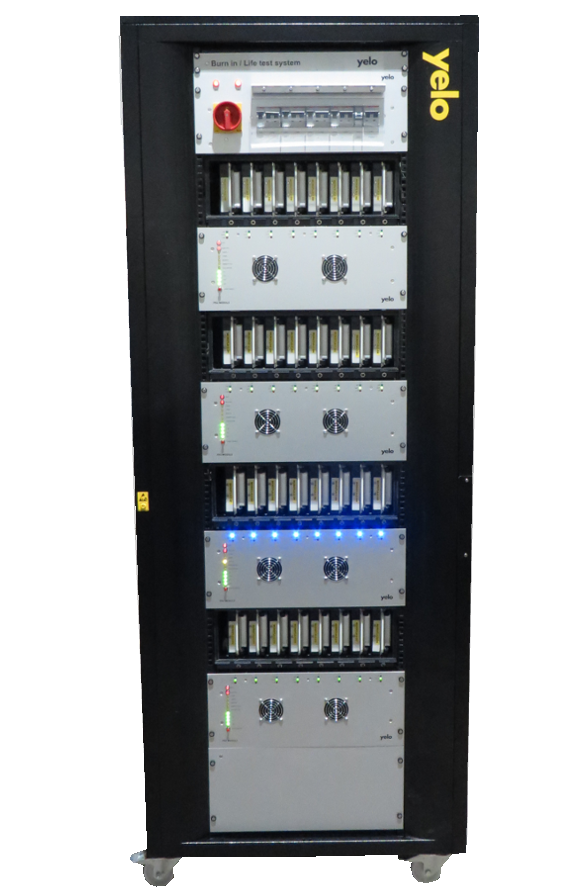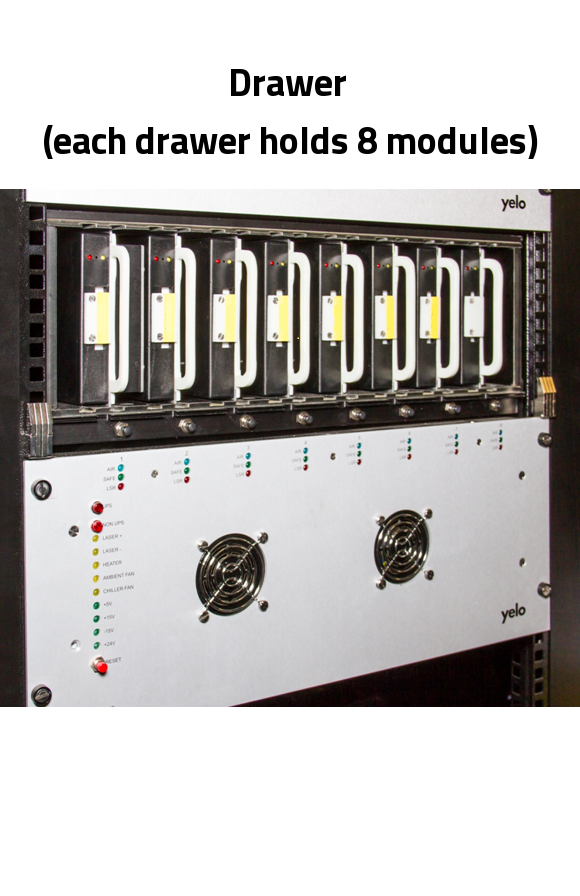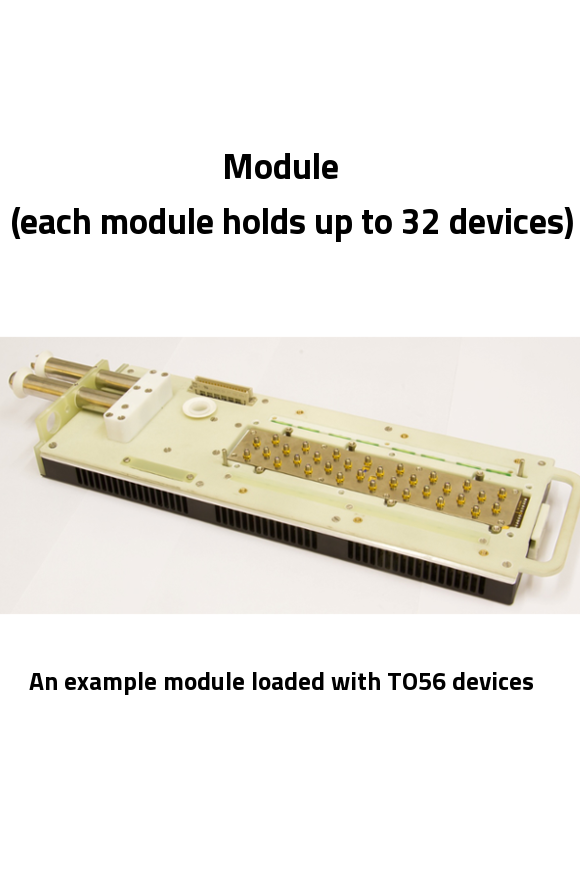Y1000S
Low Power Laser Diode Reliability and Burn-In Test System
Easily test the reliability of your low power laser devices with the Y1000S Standard burn-in and life-test system. It will quickly identify defective devices so you can prevent them reaching your customers. The Y1000S software automates threshold calculations and has an expandable capacity which helps you work through your tests more productively.
The Y1000S is ideal for testing in a Production environment.
The Y1000S is ideal for testing in a Production environment.
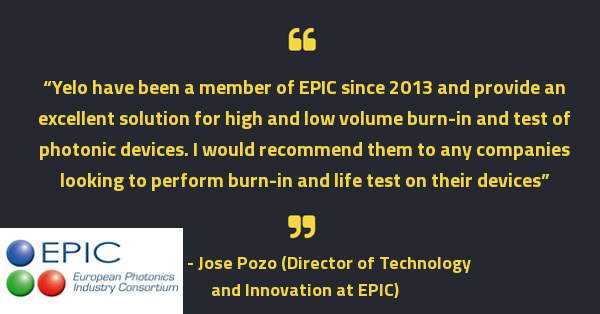
Used for Burn-In, Life Test and Vendor Qualification.
Custom built to your specification with NIST standard instruments
Ideal for testing low power devices up to 1Amp
Tests CoC's, VCSEL's, Photonic Integrated Devices and much more
Fully Expandable to test up to 2048 devices
Capable of burn-in for QFSE, SPF+ and 10G, 40G and 100G networks.
Interested in getting a quotation or some more information?
Video
A brief video explaining Yelo's burn-in and life test system.
Burn-in Software
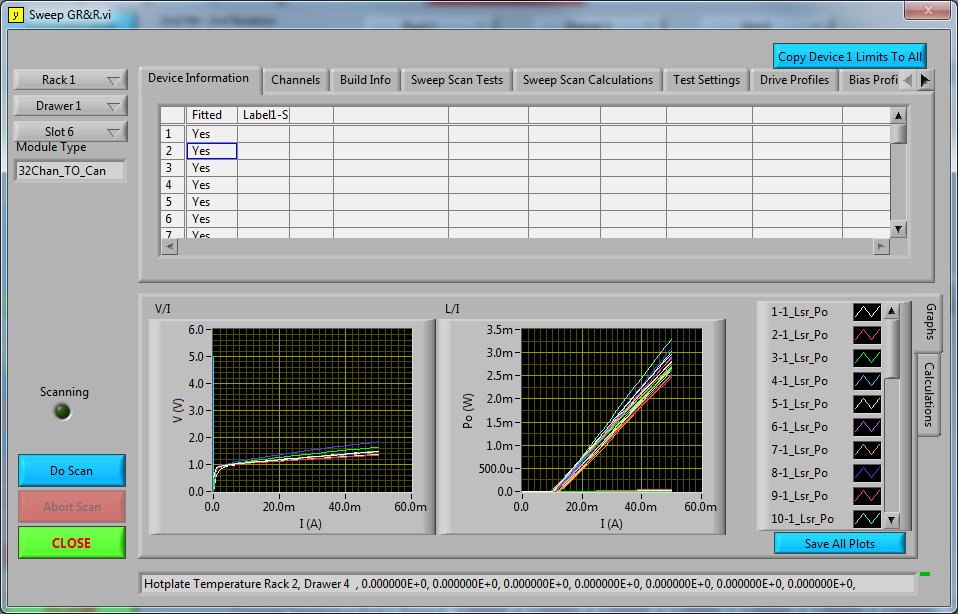
An example of Yelo's burn-in software showing the post burn-in functional tests that were performed on 32 TO-Can lasers.
LEFT GRAPH: The voltage drop across the lasers changes as more current is driven into the laser. One laser is showing an open circuit failure, displayed as a straight 5 Volt measurement.
RIGHT GRAPH: The graph on the right shows an LIV curve, where the devices have begun to lase at approximately 10mA. Threshold calculations are automated by the system software.
LEFT GRAPH: The voltage drop across the lasers changes as more current is driven into the laser. One laser is showing an open circuit failure, displayed as a straight 5 Volt measurement.
RIGHT GRAPH: The graph on the right shows an LIV curve, where the devices have begun to lase at approximately 10mA. Threshold calculations are automated by the system software.
Specification
Capacity
- Up to 2,048 devices
- 42U Master Rack
- Keithley
- 1 PC is built into the Y1000S
- Control Type: PID control
- Temperature range: 25-150 oC
- Multiple temperature control: Each module independent
- Temperature accuracy: +/- 1 oC
- 800mm x 800mm
- Optional
- 1Amp
- Yes
- ACC, APC and LIV
- Yes
- No
PACKAGES
DEVICES
- Chip On Carrier
- Chip on Submount
- TO56
- VCSEL Arrays
- VCSEL Bars
- Butterfly
- Custom Packages
DEVICES
- Laser Diodes
- Avalanche Photodiodes
- Photodiodes
- Integrated Devices
Yelo's Y1000S test system is capable of providing probed burn-in for 100G networks. Individual laser components can be tested with LIV measurements being performed in-situ during burn-in test cycles.
WHAT ARE 100G, SFP+ AND QSFP?
100G: A 100G network is comprised of 4 channels using 25Gb/s modules. Needs for optical network carriers are increasing in terms of bandwidth and capacity due to the demanding high-speed data services now offered. An industry standard was set for the modulation techniques used in 100G networks by the Optical Internetworking Forum (OIF).
SFP+: means enhanced small form-factor pluggable. It acts as an interface between a network device motherboard to a fibre optic network cable. It allows for data rates of up to 10Gb/s.
QSFP: is a quad small form-factor pluggable, consisting of four channels and is used to interface a device motherboard to a fibre optic network cable. It supports data rates from 4 x 10GB/s.
APPLICATIONS
100G optical networking is the current generation of network data transfer rate of data carriers. It facilitates server data transfer, and is crucial for effective cloud computing and networking among many companies who rely on high-speed internet and bandwidth capabilities. 100G Ethernet uses CFP modules, which support 10 x 10Gb/s (over short ranges) or 4 x 25Gb/s lanes for the optical connection. SFP+ modules have been developed for usage with optical networking. Originally the modules had transfer rates of 2.5Gb/s but this has developed over time to the 10Gb/s rates seen today. With the SFP+ module allowing up to 10Gb/s, the quad small form-factor pluggable uses 4 x 10Gb/s channels to become a 40G optical interface module.
GROWTH TRENDS OF INDUSTRY
With the continually increasing reliance on internet usage worldwide, and cloud computing becoming a dominant part of the data storage industry, there has been increased emphasis on improving data transfer rates through development and improvement of the optical networks. The next stage for optical networking is the 400G network. It is hoped that a solution for industry standardisation of modulation techniques can be achieved for this stage to aid in the transition from 100G across network carriers.
IMPORTANCE OF BURN IN AND LIFE TEST
For manufacturers, burn-in and life-tests for laser diodes involved in the optical interface modules is important as it will provide their consumers wit ha product of superior quality and reliability. Where efficiency in optical networking is of vital importance to data communications and telecommunications industries, high reliability laser diodes are crucial in providing this. Costly network downtime can be greatly reduced through the screening of laser diodes at all stages of production.For companies working with optical networks, it can be important to qualify vendor claims of module operating characteristics. There may be slight differences in operating conditions from those used in characterisation tests carried out by the manufacturer. These differences can lead to decreased life expectancy. It is therefore important that the user can fully understand how their laser diode devices will operate, and how this will effect the expected laser life-times.



